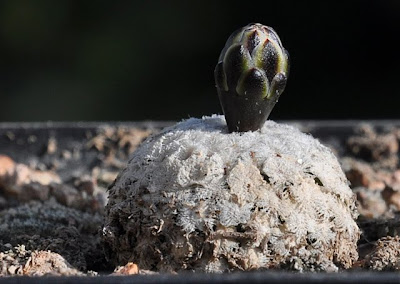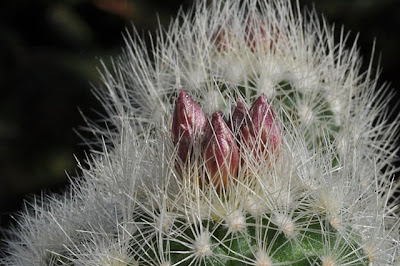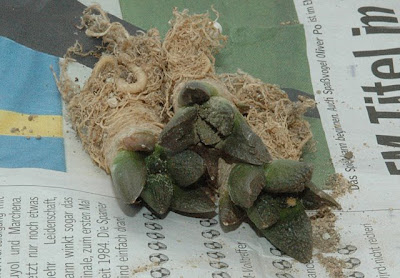
Winter dormant peyote cactus
Following a relatively mild period the last couple of years have seen freezing cold winters here in Denmark - winters that have been tough to my coldhouse grown plants, and especially the deep frost of 2009/2010 killed off a significant number of my coldhouse collection. But it also separated the wheat from the chaff leaving a pretty cold-hardy assemblage of plants, the dormant Lophophora williamsii var. echinata (JJH 8608293; Pecos River area) pictured above being a majestic example.

Ariocarpus kotschoubeyanus var. macdowellii (SB 100; El Pilar, Coahuila)
Most of the cacti growing in the coldhouse are selected for their (sometimes assumed) ability to survive freezing conditions. For example I prefer the Trans-Pecos variety of peyote as it is more frost hardy than the tender regular variety - and the different Ariocarpi all originate from the northernmost part of the species’ respective ranges.

Ariocarpus fissuratus (SB 403; Crockett Co, Texas)
Even though the cacti already have survived several cold winters I can’t deny that I still worry what plants will die off during winter (as some inevitably will).
The pictures appearing in this post were taken between Christmas and New Year - at that time the plants had already been exposed to temperatures in the vicinity of -10 C (approximately 14 F). Since then they have seen both mild and humid weather and long periods of frost - I expect that these fluctuations in temperature are harder to cope with for the plants than uniform periods of cold, but it’s just a hunch. Anyway I’m eagerly looking forward to spring :-)

Ariocarpus retusus (SB 310; Cuesta la Muralla, Coahuila)
But it is not just the cold that poses a threat to my plants. Previously critters have eaten large bites out of some of my peyote plants and now several of my Normanbokea valdeziana plants have met the same destiny... I still haven’t figured out what culprit is eating my cacti (or at least tasting and spitting out again)!

Normanbokea valdeziana (SB 1468; Ramos Arizpe, Coahuila, Mexico) eaten into by some unknown critter
Tuesday, February 12, 2013
Peyote, Ariocarpus and Normanbokea in the depth of winter
Tuesday, June 08, 2010
Flowering Normanbokea valdeziana (Turbinicarpus valdezianus)
My coldhouse grown Normanbokea valdeziana plants (SB 1468; Ramos Arizpe, Coahuila, Mexico) have flowered before but I’ve never had the chance to actually experience the bloom until a few weeks ago.

Flowering Normanbokea valdeziana
The petals are a pinkish white with a darker magenta midstripe, giving me strange associations to candy canes ;-) The filament and stigma are pure white while the anthers are a bright yellow. The flower is huge compared to the body of the plant, completely hiding it when seen from above.

Normanbokea valdeziana flower hiding plant
Normanbokea valdeziana is slow growing and its tiny feathery spines almost completely obscure the body of the plant – it is said to sometimes form clusters but all of my plants are solitary.

Normanbokea valdeziana flower
This species is capable of surviving hard, extended frost – all of my plants even made it through last winter’s extremely cold conditions without any damage.
Sukkulentarium Muthandi recently featured five flowering Normanbokea valdeziana plants, all displaying fairly different flowers.
Wednesday, April 21, 2010
The killing frost – life goes on
As mentioned in two previous posts (available here and here) this winter was extremely cold and killed off large parts of the collection I grow in an unheated greenhouse. Now spring is comming and the surviving plants are getting ready to move on.
Lophophora williamsii var. echinata with fruit
Most of my Trans-Pecos peyote plants (Pecos River area, Val Verde County, Texas; JJH 8608293) made it through the winter and is now setting fruit as if to herald the beginning of the comming growing season. If you look closely you’ll even notice a few flower buds.
Trans-Pecos peyote with budding flower
The Trans-Pecos peyote is also known as Lophophora williamsii var. echinata and is more cold-hardy than other varieties of L. williamsii
My Epithelantha micromeris plants (near Belen, New Mexico; SB1327) are also busy securing the next generation.
Epithelantha micromeris with fruit, top view
I’m getting increasingly infatuated with Epithelantha - you can’t but love the complex spination and the almost shocking pink fruits ;-) As Epithelantha has also proven to be an extremely cold hardy genus I’ll probably add more of these plants to my collection in the future.
Epithelantha micromeris with fruit
I am growing these plants at my summerhouse and not seeing them as often as I could wish. Unfortunately this also means that I miss a lot of the flowers including those of the Normanbokea valdeziana and Acharagma roseana pictured below.
Normanbokea valdeziana about to flower
Acharagma roseana about to flower
Fortunately fruits are more persistent than flowers giving me the opportunity to enjoy sights like the orange-red berries of Escobaria missouriensis (Mesa County, Colorado; SB204)
Escobaria missouriensis with fruit
My Maihuenia patagonica are thriving after the winter but not exactly flowering or setting fruit. I don’t have much experience growing Maihuenia - I originally fell for Maihuenia poeppigii but being a completist I ordered M. patagonica seeds as well. All the M. poeppigii plants succumbed to the frost this winter while the M. patagonica plants only suffered a few casualties. I'm not sure I’m treating the plants right, though, as they are growing strangely lanky, far from the dense, clustering habit I have seen in pictures (and the plants are getting plenty of light).
Maihuenia patagonica
And now for something completely different.
My summerhouse is located on the west coast of Denmark overlooking the North Sea. This weekend the Sun set in a sky looking much more orange than usual, and slightly diffused as by a thin haze. 
The Sun setting in a haze of ashes from the Eyjafjallajökull eruptions
I take this to be caused by the Eyjafjallajökull volcano eruptions that have been sending a vast, invisible plume of grit drifting over Europe and kept most of European airspace shut down for several days. Of course one could imagine that a sunset like this was caused by a thin layer of clouds, but I have enjoyed hundreds of sunsets from my terrace and never seen anything like this before.
Sunset with a diffuse halo of refracted light – probably caused by Eyjafjallajökull ashes
On a different note, the Eyjafjallajökull volcano eruptions almost got me stuck in Amsterdam (not the worst place to be stuck in, by any means ;-) I and a colleague were supposed to have flown home in the late evening of April 15, 2010 – but as we watched more and more flights getting canceled and increasing parts of the north-western European airspace being closed down we agreed to rent a car. So in the early afternoon we set out on a long drive home – which in hindsight was an extremely wise decision as Danish airspace is only opening again today ;-)
Sunday, July 20, 2008
New plants for the coldhouse
Last week I received a new batch of plants from Kakteen Kliem. The plants are going to live in my coldhouse so I selected plants originating from habitats where they are naturally exposed to frost - I hope this also gives them the ability to withstand the freezing conditions they have to endure during winter here in Denmark. 
Lophophora williamsii (JJH 8608293; Pecos River, Texas)
I already have several of these Trans-Pecos Lophophora williamsii plants but decided to procure a few more as Kliem’s stock is running low.
Ariocarpus fissuratus (SB 403; Crockett County, Texas)
My few coldhouse grown Ariocarpus fissuratus plants have all survived until now so I felt like adding some more to the collection ;-)
Homalocephala texensis (DJF 891.3; Yoakum County, Texas)
Homalocephala texensis (aptly named the “Horse Crippler”) is a first for me - I’m looking forward to watching these plants grow and develop their characteristic heavy spine armor.
Normanbokea valdeziana (SB 1468; Ramos Arizpe, Coahuila, Mexico)
Normanbokea valdeziana is another first. I’m not quite sure what to expect from these plants but I fell for their fuzzy looks and beautiful flowers.
As always Gerhard Kliem’s plants are of an excellent quality.
All Time Most Popular Posts
-
Lophophora williamsii (peyote) populations have diminished in large areas of South Texas where peyoteros harvest the cactus for ceremonial ...
-
On various occasions I've been asked what growing media I'm using for my cactus plants. I don't have a set soil mix recipe as su...
-
Below is a list of retailers/nurseries selling cactus seed and plants. I've only listed vendors I've done business with. If you ar...
-
Most cacti are easily grown from seed - and with a little patience and care they can be grown into beautiful plants. Lophophora williamsi...
-
In last month’s post on the troubled Texan peyoteros I referred to Anderson’s article on the peyote situation in Texas. Given the importanc...
-
Yet another slightly off topic and probably not entirely politically correct post, but I couldn’t help noticing the similarity of my monstr...
-
Flowering stand of San Pedro cacti (Trichocereus pachanoi) To me the main draw of the San Pedro cactus ( Trichocereus pachanoi (syn. Ech...
-
In the June 2008 issue of the Cactus & Co magazine Jaroslav Šnicer, Jaroslav Bohata, and Vojtěch Myšák described a new Lophophora spec...
-
There seems to be an increased focus on the alarming Texas peyote situation. A couple of weeks ago the Houston Press published a mournful, i...
-
I spent two weeks working in Delhi, India during January. I had one weekend off and had planned to spend it in Delhi at my own leisure, but ...


















